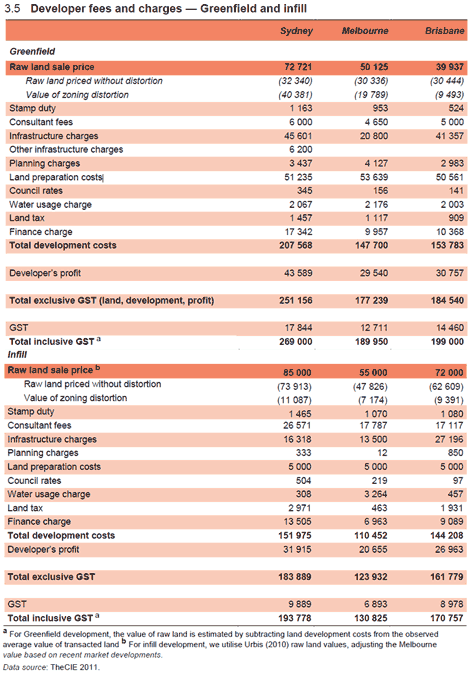Sydney most profitable residential market for developers as Melbourne costs rise: Report

Profits margins on new residential developments are substantially higher in Sydney then they are Melbourne and Brisbane, according to a new report by the Centre for International Economics.
The Taxation of the Housing Sector report shows that average profit on a Sydney greenfield lot (new housing estates) is $44,000 compared with profits of around $30,000 in Melbourne and $31,000 in Brisbane. The report was commissioned by the Housing Industry Association (HIA) to highlight the high taxation burden faced by the housing sector and back last September’s call for urgent taxation reform.
Click to enlargeThe story is similar for infill lots (redeveloped land in a build-up area) with Sydney generating developers profits of $32,000 compared to $21,000 in Melbourne and $27,000 in Brisbane.
Not only are Melbourne lot sales less profitable than those in Sydney and Brisbane, but Melbourne land developers are also facing higher council contribution levies.
The Property Council of Victoria estimates that development charges levied on Melbourne developers as part of local council development contribution plans (DCPs) increased about 26% over the past year.
The one-off charge paid by Victorian developers is used to fund essential infrastructure such as roads, sewers, drains and utilities.
Jennifer Cunich, executive director at the Property Council of Victoria, told the Australian Financial Review that costs levied on developments had suffered from rising construction costs, higher land values, larger open space requirements from local councils and higher conservation costs.
In May last year Victorian planning minister Matthew Guy promised to overhaul the way the contribution charge is levied on developers, but to date no changes have been implemented.
The CIE report notes that raw land sale price in some jurisdictions contains a hidden tax component resulting from the “monopoly of supply that local councils and state governments have over land release.
“This hidden tax is apparent where the raw land sale price is greater than the value of similar land that is not designated as available for residential use, such as agricultural land.
“Development costs, other than taxes, include land preparation costs, consultant fees, finance charges, council water rates, and development profit.
“Some of these charges may amount to taxes and inefficiencies if they are excessive relative to what they need to be.
“Planning delays add to financing costs and represent hidden taxes upon which the goods and services tax cascade as the developer tries to recuperate all development costs.
“Land preparation costs incorporate the cost of installing the National Broadband Network (NBN). This may represent a tax on housing for some residents whose net gain from the installation of the NBN is lower than the net cost.
“Consultant fees incorporate a hidden tax component where the cost of activities related to compliance is disproportionate to the benefits flowing from compliance (such as to third parties),” says the CIE report.
The CIE report also notes that government taxes and charges are significantly lower on infill dwellings, reflecting lower ambiguous taxes (charges imposed by state governments and local councils ostensibly for the provision of infrastructure) and charges such as infrastructure charges and a smaller anticipated impact of zoning restrictions on a given dwelling.
